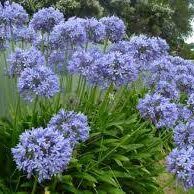Seasonal Agapanthus Treatment: Planning For Winter Months and Summer season
Seasonal Agapanthus Treatment: Planning For Winter Months and Summer season
Blog Article
Unleashing the Secret to Successful Agapanthus Farming: Idea for a Flourishing Garden
In the world of gardening, cultivating agapanthus efficiently needs a critical method that incorporates numerous facets of plant care. With cautious attention to detail, one can unlock the keys to nurturing these spectacular blossoms, bring about a garden that thrives with charm and vibrancy. By recognizing the subtleties of agapanthus farming, one can develop an atmosphere where these plants grow and bloom perfectly. In the complying with conversation, we will certainly explore important tips and tricks that will guide you in the direction of a prospering agapanthus yard, offering understandings into ideal methods, soil conditions, watering methods, and much more.
Planting Agapanthus: Best Practices
When growing Agapanthus, appropriate dirt prep work is necessary for making sure successful growth and development of these lovely flowers. Agapanthus, commonly understood as Lily of the Nile or African lily, grows in well-draining soil with a somewhat acidic to neutral pH degree - Agapanthus. Before growing, it is essential to change heavy clay dirts with organic issue such as garden compost or peat moss to boost drainage and give essential nutrients for the plants
To plant Agapanthus, choose a location that receives complete sunshine to partial shade, as this will certainly advertise healthy and balanced growth and bountiful flowering. Dig a hole two times the diameter of the plant's origin sphere and position the Agapanthus at the very same deepness it was formerly growing. Carefully backfill the opening with dirt, pushing down securely to eliminate any type of air pockets around the roots.
Water the freshly planted Agapanthus completely and proceed to keep the soil equally damp, specifically throughout the plant's active expanding period. Agapanthus. Using a well balanced fertilizer once a month can further sustain the plant's growth and flowering. By following these best methods for growing Agapanthus, you can create a sensational display of these exciting blossoms in your yard
Ideal Dirt Issues for Agapanthus
For optimum growth and blooming success of Agapanthus plants, making certain the soil conditions are excellent is critical. Agapanthus prefers soil that is rich in nutrients, so integrating a well balanced fertilizer during the expanding period can promote healthy and balanced growth and vibrant flowers.

Watering and Feeding Tips
To guarantee healthy and balanced growth and dynamic blooms, appropriate watering and fertilizing strategies are vital for effective Agapanthus cultivation. Agapanthus plants profit from routine watering, particularly throughout the growing period.
When it pertains to fertilizing these details Agapanthus, a balanced plant food with equal parts nitrogen, phosphorus, and potassium can be used in the springtime to promote healthy growth and blooming. Slow-release plant foods are optimal for supplying nutrients gradually over an extended period. Prevent over-fertilizing, as this can cause extreme vegetation development at the expenditure of blooms.
Furthermore, incorporating natural matter like compost into the dirt can improve nutrient levels and boost soil structure, assisting in the overall health of the Agapanthus plants. By adhering to these watering and fertilizing tips, gardeners can ensure their Agapanthus plants thrive and produce stunning display screens of blossoms.
Trimming and Deadheading Methods
Correct trimming and deadheading techniques play a vital function in keeping the wellness and visual appeals of Agapanthus plants, enhancing the important practices of watering and fertilizing for successful cultivation. Trimming Agapanthus includes getting rid of invested flower heads, yellowing or dead fallen leaves, and total shaping of the plant to advertise far better development. Deadheading, the procedure of getting rid of faded flowers, not just enhances the plant's look however also encourages more flowering.
When deadheading Agapanthus, it is suggested to trim off the blossom stem at the base utilizing sharp, clean shears. This process reroutes the plant's power from seed manufacturing back right into this root and foliage growth, promoting a much healthier and extra robust plant. Normal deadheading can extend the flowering period of Agapanthus dig this and prevent self-seeding, which can bring about overcrowding.
In regards to pruning, Agapanthus generally advantages from a light trim after blossoming to clean up the plant and encourage fresh development. Reducing the invested flower stems and eliminating any kind of dead or damaged vegetation assists keep the plant's vigor and general look. Nevertheless, it is necessary to avoid cutting into the crown of the plant, as this can damage its health.

Protecting Agapanthus From Pests and Diseases
Executing efficient pest and illness monitoring methods is important to protecting the health and vigor of Agapanthus plants in growing. One usual bug that affects Agapanthus is the Agapanthus borer, a caterpillar that tunnels into the plant, creating damage to the leaves and flowers.
In addition to bugs, Agapanthus are vulnerable to conditions such as origin rot and fungal fallen leave spots. By staying cautious and resolving pest and illness problems promptly, garden enthusiasts can help their Agapanthus prosper and prosper.

Verdict
Finally, successful cultivation of agapanthus calls for correct planting techniques, perfect dirt problems, sufficient watering and feeding, normal trimming and deadheading, and protection from parasites and conditions. By complying with these ideas and techniques, garden enthusiasts can ensure a growing yard filled up with lovely agapanthus blooms. Agapanthus. Bear in mind to preserve constant care and attention to detail to promote the wellness and longevity of these stunning plants
When planting Agapanthus, appropriate soil prep work is necessary for making certain successful growth and growth of these lovely flowers.Water the freshly planted Agapanthus extensively and continue to keep the soil uniformly damp, specifically during the plant's energetic expanding season.For ideal growth and growing success of Agapanthus plants, guaranteeing the soil conditions are ideal is critical. When planting or transplanting Agapanthus, ensure the soil is well-prepared to supply the necessary foundation for the plants to develop themselves effectively. One typical bug that impacts Agapanthus is the Agapanthus borer, a caterpillar that passages into the plant, creating damages to the leaves and blossoms.
Report this page